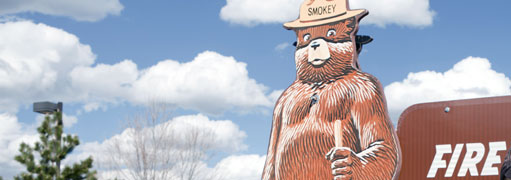Sunbear Vierra wears a wildland firefighter uniform to his interview with the Alibi . He has to be prepared to leave at a moment’s notice. Donning flame-resistant pants and a Forest Service T-shirt, Vierra says he’s not optimistic about this year. “It looks bad," he says. "It is on par to be one of the worst fire seasons on record. It’s not quite there yet," he adds, but it has all the markings. According to smokeybear.com, more than 3 million acres have burned in the United States so far.Vierra’s an engine crew captain who fights fires primarily in New Mexico. 2009 and 2010 saw more moisture in the state than usual, he says, and that meant fewer fires. The high rainfall and snowpack might seem like a good thing in the desert, but it also leads to perennial grasses popping up all over the forest. Add in this year’s lack of moisture, he points out, and those grasses are dry and prime for ignition.Deepening the potential danger are heavy spring winds, he adds, which are common. Just as in the Gila National Forest where a human-caused blaze destroyed more than 81,000 acres as of press time, fires can swiftly become infernos.The good news is this year there have been significantly fewer lightning storms, Vierra says, so natural starts are less common so far. But there’s another element that’s hard to predict: "We don’t have control over the human-caused aspects of it. We can put out there the prevention methods, but really it’s hard to get that through sometimes,” he says. “That’s unfortunate."Vierra’s been doing this since 1997. Burned-out on construction and home for the summer, a family friend suggested he try firefighting. He joined a crew with the Fish and Wildlife Service in southern Arizona, and the work pulled him in. "It either grabs you or it doesn’t grab you," he says.There are two elements of the job that keep people hooked: "adrenaline rushes or just the overall thought for stewardship of the land." These days Vierra is driven mostly by his desire to leave the land he protects better than when he began. "The job, it’s fun," he smiles. "I still enjoy the aspects of wildland firefighting"—including the rush.Vierra has worked different jobs in the field for multiple agencies, ranging from Initial Attack squads that hike into the blaze to his current position as an engine crew captain. The crew’s primary responsibility is to be first on the scene of an inferno, where the firefighters begin "laying line." This entails burning space around a road or a ditch—and sometimes digging the ditch. The tactic was used in the Gila to save ponderosa pines. The idea is to create a barrier that lacks fuel. Laying line, Vierra says, is one of the most important parts of fire suppression. "Otherwise, it would be off to the races more,” he says.Attitudes about combating fires have changed over time. Vierra says the Forrest Service used to wage an all-out war on fire. The Great Fire of 1910 burned 3 million acres across the Northwest. That and other large blazes caused the Forest Service and the general public to view forest fire as a serious enemy.Vierra says this was the beginning of the 10 a.m. policy. Regardless of when a crew hit the ground, the fire was supposed to be totally suppressed by 10 a.m. the next morning.Due to the excessive containment, the fires were "not cleaning up the debris, the brush, the lower understory trees," he says. Instead, there was vast overgrowth, which increased the danger of another blaze. By the mid ’60s, the Forest Service realized its mistake. "We have changed that policy," Vierra says. "We are now in the mindset of, We need to manage fires for a holistic approach." Now some fires—because they are remote or dangerous to firefighters—are fought with what’s called an "appropriate management response." That can be simply keeping the flames away from structures and people, he says, but mostly leaving it alone.For most of New Mexico’s forests, there is a ban on all open fires. The Forest Service asks that you never toss cigarette butts out your window when driving. Vierra advises people "just to be overall aware that this is fire season." Every season promises to be a different creature in its own right, he says. When you go into the woods, "use a lot of common sense."





